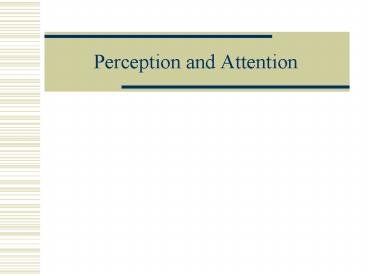Perception and Attention - PowerPoint PPT Presentation
Title:
Perception and Attention
Description:
Three aspects, feature analysis (bottom up processing), unitization, and top down processing ... Unitization. Matching sets of features with long term memory to ... – PowerPoint PPT presentation
Number of Views:59
Avg rating:3.0/5.0
Title: Perception and Attention
1
Perception and Attention
2
Information Processing Model
- models human thought like its a computer
3
Attention Resources
Response Selection
Response Execution
Sensory Register
Perception
Thought Decision Making
Working Memory
Long Term Memory
feedback
4
Controller
Feature Detectors, Pattern Recognition
Output Routines
Output, Motor actions
Sensors
AI System
RAM
Disk storage
feedback
5
Processing
Response
Perception
Attention Resources
Response Selection
Response Execution
Sensory Register
Perception
Thought Decision Making
Working Memory
Long Term Memory
feedback
6
Perception
- compares incoming sensory data to stored
knowledge - reduces from many pieces of data to meaningful
units - Three aspects, feature analysis (bottom up
processing), unitization, and top down processing
7
Feature Analysis
- Analysis of the raw features of an event
- Colour, size, shape, loudness
A
A
A
A
8
Unitization
- Matching sets of features with long term memory
to create units - E.g. reading words in a familiar language vs an
unfamiliar language
9
- things are built up hierarchically
- feature-gt letter -gt word -gtsentence
A
Apple
unitisation creating a unit out of features
10
Objects
- Can also be broken down into features, and
conversely unitized
11
Design Implications of Feature Analysis
- Speed and accuracy greatest for most often seen
fonts (use a common font) - For single words (labels) use all caps. STOP
- For sentences use upper and lower case, NOT ALL
CAPS ITS HARD TO READ - Use print not script.
12
Design Implications of Feature Analysis
- Minimize abbreviations and use complete words
when possible (min abb.) - If you have to abb. trunc. dont abvt.
- Leavespacesbetweenwords.
13
Top Down Processing
- Uses the context of the situation to resolve the
image - Occurs simultaneously with bottom up processing
- resolves ambiguous situations in the absence of
clear physical features - your expectation of what youll see affects what
youll see
14
Exercise Feature Analysis and Top Down
Processing in Conflict
15
(No Transcript)
16
(No Transcript)
17
(No Transcript)
18
(No Transcript)
19
(No Transcript)
20
(No Transcript)
21
Attention
- focuses resources
- like a spotlight
- filters out what you dont need to know
- shifts
- multi-tasking when driving in a straightforward
situation (drive, radio, friend) - focus when in heavy traffic, or accident seen
22
Two Kinds of Attention
- Selective attention
- Focusing on the environment with the goal of
extracting certain information - Divided attention
- Processing two sources of information at once
23
Divided Attention Resource Demands
- Difficult tasks reduce ability to divide
attention - Resource theory (Kahneman, 1974)
- Mental resources are shared by tasks
- Mental resources are finite
- Two tasks share resources
24
Divided Attention Structural Similarity
- People have multiple pools of resources
- Auditory vs. visual senses
- Spatial vs. verbal cognitive demands
- Stages of processing (memory vs. responding)
- Visual channel (focal vs. ambient)
- Tasks share resources within a pool
- Multiple resource theory
25
Divided Attention Task Confusion
- More similar tasks will cause confusion
- Baseball scores and math
- Auditory background and words
- How does this explanation fit with multiple
resource theory?
26
Divided Attention Task Management
- Users choose a primary task vs. secondary task
- Strategies
- Doing secondary tasks when primary task allows
- Success relies on switching appropriately
27
Automatic and Controlled Processing
- when tasks are new they take alot of attention
(e.g. learning to drive) - Controlled processing Effortful cognitive
processes that require attention to initiate and
sustain them - With practice become automatic
- Automatic can be run without cognitive demand on
attentional resources
28
How do things become automatic?
- High degree of consistency
- Extremely strong mappings between world and
required action
Action
World
STOP
29
Design Implications of Attention
- use strong mappings to make things automatic
- exploit visual and auditory information to share
attention on different resource pools - make most critical things most salient (visible)
to capture attention - attention is competitive!
30
- SPOT exercise































